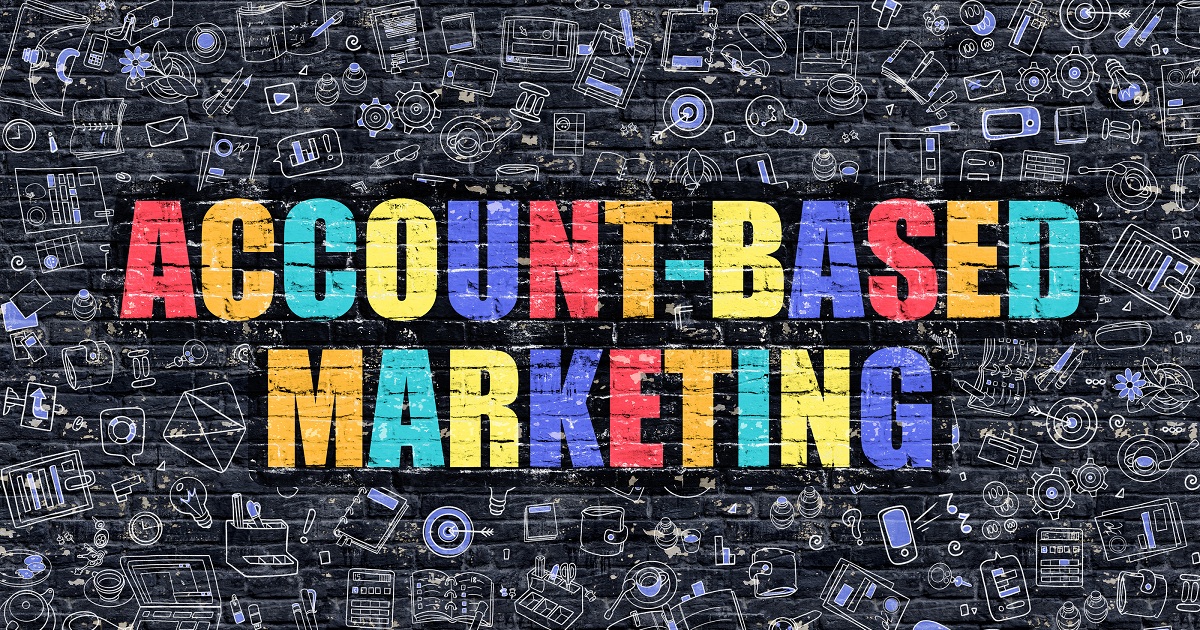
Account Based Data
Article | June 29, 2023
Account-based marketing is the ultimate personalization tool.
Instead of incurring unnecessary marketing expenses, an account-centric strategy segregates vital business accounts and markets directly. This means, by appealing to specific market leaders, who can benefit from what your company has to offer, you can make marketing efforts more tailored and effective.
ABM strategy is not new by any means. Still, it has gained widespread recognition over the past few years as it's evolved along with the progression of technology. An entirely tech-based, the marketing automation solutions have made account-based marketing more measurable and affordable for all-sized businesses. Thus, ABM automation gained pace.
Research from Marketo suggests that account-based marketing delivers a better return on investment than other various strategies for 97% of marketers.
Marketing automation plays a vital role in driving impressive results. It allows companies to target their outreach based on interests and actions. But what makes ABM automation win the rat race?
ABM Automation: AI is the Driver
The reason why ABM automation has recently emerged is the availability of AI. Initially, AI was used by ABM to propel the automatic selection of target accounts through predictive analytics. Also, it is driving intelligent marketing nurturing and other marketing responses based on how the targets respond, their needs, and so on.
If you're targeting 100 accounts as potential new corporate customers, those accounts will visit different pages of your site. Some will download white papers and respond to emails. You will get leads from the targeted companies through these activities, and thus you can knock at their door.
AI enables quick responding to a dynamically changing engagement in the ABM platform and delivers the best action. This is how automation with AI is emerging in ABM platforms.
You can take four steps to automate your ABM to drive leads and create a successful ABM automated platform.
4 Steps to Plan ABM Automation
Draw the Automation Cycle
To start with ABM automation, firstly, create a blueprint of the targeted business. In this, you should identify the complete process of lead generation. The trail looks like; subscriber, lead, MQLs, SQLs, and a client to target. In this process, you cannot communicate at each phase. When one clicks on the particular link of your website, you should have a system-generated mail to send.
Once you track the movement of the lead, quickly trigger the sales team to take the follow-ups. This saves the time of salespersons, and therefore ABM strategies are implemented wisely.
Integrate your ABM automation software and CRM
Before you build your account-based marketing campaigns, you'll have to integrate your ABM automation software and CRM.
Integrating marketing automation tools is vital in the automation process. If your ABM software doesn't interact with the email marketing software, you won't be able to automate the process. In addition, if it doesn't relate to your CRM, it will be difficult to know if leads converted into accounts and track the ROI of an account-based campaign. So, to integrate ABM automation, you'll have to research and keep ICP, content, target accounts, and CRM all in one place.
Tailor Your Content
Ensure you're sending the right message to the right target account. Creating customized landing pages looking at how people have recently interacted with your brand is a great way to execute automation. Using ABM tools, you can automatically message target accounts with relevant messages when they engage with you and help you build the connections that become conversions.
Create Dashboard to Assess Efforts
The last step to automate your ABM platform is to track and measure the efforts you have put in to see information at-a-glance.
You get information about your target accounts on your dashboard, such as open deals, company score, total pipeline, and the number of decision-makers identified. In addition, you should consider ongoing A/B tests when started with ABM automation. This is because you can see what messaging appeals to your ICP (Ideal Customer Profile).
ABM is a result-driven approach. ITSMA reports that 87% of marketers consider ABM as delivering the highest returns. But without automation, ABM becomes a strewn process. Marketing automation lets your team offer a personalized approach and immediate outreach with valuable content that pushes visitors to become regular clients. Thus, using ABM software tools — ideally the marketing automation tools — can help you automate and scale your strategy and adds value to your ABM efforts.
Frequently Asked Questions
What are the account-based marketing tactics?
Account-based marketing uses hyper-personalized tactics to attract, engage, and convert high-value accounts. Similarly, it uses emails to contact existing customers and target consumers and social media channels like LinkedIn, Facebook, and more to reach out to prospects.
Why is an account-based marketing strategy so important?
The importance of ABM lies in structuring marketing efforts and resources on key accounts to drive the most revenue. ABM maximizes the efficiency of your B2B marketing resources along with building the communication channel with sales to align with sales and marketing functions.
How to create the automated ABM strategy?
To create the automated ABM strategy, follow these steps:
Create your Ideal Customer Profile (ICP)
Align your target accounts
Build campaigns
Integrate ABM, marketing automation software, and CRM
Personalize content
Engage
Set up a dashboard for assessment
{
"@context": "https://schema.org",
"@type": "FAQPage",
"mainEntity": [{
"@type": "Question",
"name": "What are the account-based marketing tactics?",
"acceptedAnswer": {
"@type": "Answer",
"text": "Account-based marketing uses hyper-personalized tactics to attract, engage, and convert high-value accounts. Similarly, it uses emails to contact existing customers and target consumers and social media channels like LinkedIn, Facebook, and more to reach out to prospects."
}
},{
"@type": "Question",
"name": "Why is an account-based marketing strategy so important?",
"acceptedAnswer": {
"@type": "Answer",
"text": "The importance of ABM lies in structuring marketing efforts and resources on key accounts to drive the most revenue. ABM maximizes the efficiency of your B2B marketing resources along with building the communication channel with sales to align with sales and marketing functions."
}
},{
"@type": "Question",
"name": "How to create the automated ABM strategy?",
"acceptedAnswer": {
"@type": "Answer",
"text": "To create the automated ABM strategy, follow these steps:
Create your Ideal Customer Profile (ICP)
Align your target accounts
Build campaigns
Integrate ABM, marketing automation software, and CRM
Personalize content
Engage
Set up a dashboard for assessment"
}
}]
}
Read More

Buyer Intent Data
Article | October 7, 2022
Many businesses employ Software-as-a-Service (SaaS) for its flexibility and simplicity to fulfill their marketing requirements. Different types of SaaS marketing platforms help companies simplify their marketing needs. But growing a SaaS company isn’t easy. It is quite challenging because the industry is flooded with competition. Research had predicted very early on that 73% of the companies would turn all their apps into SaaS by 2021, making SaaS competition fiercer than ever. Marketeers eye for consumers’ already limited attention spans in B2B and B2C spaces.
Read More

Account Based Data
Article | August 19, 2022
Account-based marketing (ABM) is becoming more popular as companies begin to realize that traditional funnel marketing does not produce the same results it used to in the B2B space. ABM gives the ability to personalize sales and marketing outreach on the account level, and technology helps us do it at scale. In this article, we uncover the best tactics you can implement in your ABM strategy to personalize your outreach for marketing, sales & service.
Read More

Account Based Analytics
Article | December 28, 2021
Inbound Marketing
Businesses put effort into designing their inbound marketing strategies to seek growth opportunities. In inbound marketing strategies, target audiences are attracted, engaged, and delighted by businesses by using valuable content. They also communicate with the customers regularly through inbound sales calls and keep the customers happy through timely and prompt assistance.
Businesses use an inbound marketing strategy that they have trusted for years, while some still struggle to grasp the power of inbound marketing. In both cases, if the strategy doesn’t show the expected results, it becomes a matter of immediate concern.
Why Should You Conduct an Inbound Marketing Audit?
In an interview with Media 7, Daniel Englebretson, Founder of Khronos, talked about rise of AI in ABM and the success of marketing programs.
“The best programs, and the best marketers, have built their success on the back of rapid iteration and a long history of testing, learning, and continuously improving.”
Continuous improvement in marketing can happen only when you carry out regular assessments or audits of your marketing strategy, inbound, and outbound.
A marketing audit looks at the business environment, strategy implementation, systems, organization, productivity, and function of the strategy. It is undertaken when there is a change in leadership, the business is lagging compared to competitors, has rapid growth or is terribly stuck, or when a design overhaul is planned.
Here is why you should conduct an inbound marketing audit:
Identifying Weaknesses
If an inbound marketing strategy suddenly stops working, you need to find its weaknesses and remedy them in time to get the best results. This is called “strengths, weaknesses, opportunities, and threats” (SWOT) analysis.
An audit will help you analyze the effectiveness of the channels and the tactics you use as compared to industry standards and find out the reasons behind ineffective lead generation. An effective audit also rigorously checks the marketing tools your team uses.
You can make adjustments and improvements to the strategy based on the audit. You can look into channels like websites, paid search, email marketing, social media, and organic search to assess the performance of your strategy.
Spotting Growth Opportunities
When expanding the business, introducing a new product or service, conducting an audit can add great value to your plan. You can evaluate your business position, rate your customer satisfaction and engagement, know how well you are exploiting your existing opportunities, and if you are using the right channels and messaging to get in touch with your target audience.
If you find anything amiss, you can promptly deploy resources to course-correct your team and work towards a better ROI through the inbound marketing strategy.
Reaffirming Goals
Reaffirm your marketing and business goals by assessing important data-driven perspective metrics like keyword ranking, post engagement, customer acquisition cost (CAC), email click-through rate, and lead quality. For example, if your website is not optimized for SERP and doesn’t grab the attention of your users, it could be the reason behind ineffective lead generation. In such a case, you can re-evaluate your content strategy.
Things like text-to-image ratio on web pages, irrelevant images, and weirdly placed call-to-action (CTA) buttons can affect the user’s journey. If some pages are unresponsive on mobiles or tablets, then the audit will help you find those and implement appropriate solutions.
Knowing what is working and what isn’t helps you know what you need to do next to get optimum results from your inbound marketing strategy.
Keeping Your Team Motivated
Every team is a defined stakeholder in the company's success. Right from the sales team, customer experience, IT architects, c-suite, product developers, to your marketing team, everyone will know their strengths and weaknesses through the audit. A regularly conducted marketing audit will keep your teams motivated to perform their duties well.
Boosts ROI
Boost your ROI by ditching things that do not work. Allocating resources to your business strengths instead of your marketing weaknesses will help you get the ROI you expect. You can also focus on introducing new plans to revive the part of the strategy that is no longer working. It can be anything from redesigning a few website pages to hiring a new SEO expert.
What Does a Strong Inbound Marketing Audit Look Like?
A strong marketing audit yields results that enhance your strategy, improve your ROI, and help you step up your game so you don’t fall behind in the race with your competitors. These are the characteristics a strong inbound marketing audit will have:
Autonomy
An effective audit should be autonomously conducted by a third-party auditor so you do not skip the hard parts and the management completely cooperates in the process. The more stringent the audit, the better the understanding of potential growth opportunities, managerial snags, and resource allotments.
Perfect Structure
The audit has to be systematically structured to cover all bases, like contact channels, business environment, customer experience, design, engagement, SEO, SMM, and sales management, so no crucial elements are missed.
Conducted Regularly
Conduct the audit at regular intervals of time, at least once a year. It should be a part of your marketing calendar or your strategic marketing plan.
Business-specific
The audit should factor in the technology, expertise, and experience of your business. It should consider factors like political, legal, and socio-cultural issues that arise from the location of your business. Competitors, best practices, and conditions should also be considered.
How Eclipse Software Saw a 370% Increase in Organic Traffic in a Year
Manchester-based software company Eclipse Software hit a snag when their online presence wasn’t translating into revenue, leads, or ROI. They hired Noisy Little Monkey, a service-based digital marketing agency in the UK, to help them boost their online presence. Noisy Little Monkey ran a marketing audit for them and found issues like page speeds and content offerings, and they ran campaigns using gated content. As a result of such campaigns and website improvements, Eclipse Software saw a 370% rise in their organic traffic in a year, with a conversion rate of 3.7%.
Key Takeaways
An inbound marketing audit is crucial for identifying the strengths and weaknesses of your marketing strategy. It can tell you which areas need improvement, how to allocate your resources better, and how to increase your growth opportunities and ROI through data-driven perspectives and more to achieve better results.
FAQ
At what time interval should you conduct an inbound marketing audit?
Every business should conduct an audit once every six to twelve months.
What are the characteristics of an inbound marketing audit?
An inbound marketing audit should be autonomous, periodically carried out, systematic and business-specific.
Read More